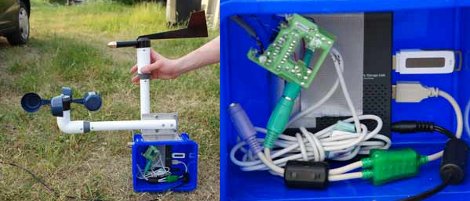
Sometimes when we look at a hack, its to see how someone chose those parts for the project. In this case, it would have been hard to see it coming. [Janne Jansson] decided to combine a set of measuring cups, a hacked Linksys NSLU2 NAS, and a PS/2 Mouse together to make a self-contained Wind Speed Sensor for his roof. The measuring cups act as wind catchers, which in turns drives the rotation of one of the mouse ball sensors. This data is then logged and transmitted by the NSLU2. The NSLU2 is running a custom Linux based firmware, similar to how OpenWRT works for wireless routers.
To calibrate the device, he also made the best logical choice: to duct tape it to the hood of his car along with a much more expensive wind sensor and use that data to make his own device as accurate as possible. When placed atop his house with a 1500VA 220V UPS, the device managed 250 days of uptime before meeting its demise. Those 250 days also included 5 days of being frozen solid, yet still transmitting (somewhat meaningless) data. All of the relevant code and build instructions are available, for those of you with similar parts to spare.















I wonder why the UPS was required? I would’ve expected it’d be cheaper/more efficient to run the NSLU2 off a battery, apparently it only needs a 5V DC source.
The NSLUG2 was nice for a minimal Debian armel distro. Setting up the OS swap/logs etc. to take it easy on the flash drive is a bit involved.
The OS could be upgraded to run on the Docstar if it was a more recent installation.
My only complaint about the NSLUG2 was the limited performance when connecting web cams.
However, I did like the fact mine cost under $20 including a new 8GB usb flash drive.
Surely the cups have to be a particular size, shape, weight? I think my issue with this is the device needs calibrating at a selection of windspeeds. Requiring a wind speed meter. If you have one, why make one?
@Kodman When you need two! :P
i am making a wind turbine and a wind speed and direction monitor would be useful, i was thinking of building it into the turbine but have no idea how to transmit the data, i was thinking mabe sensors connected to an arduino with an ethernet sheild so the data could be veiwed via wifi on my laptop or via the internet, but having a router up there would be useful. i have a couple of spare ones but have no idea how to program them. or i could use some sort of micro controller with a composite out because i’m going to have a cctv camera up there to monitor it and that way i could have the camera and the windspeed data coming into seperate video channels on my web enabled dvr. any help would be great. my e-mail is: ljthevj@googlemail.com
if you can, please help me find a way, i am only 14 so am trying to learn as mutch as i can at the moment.
thanks in advance :)
@Kodman
There is no prefect wind meter really. The mass of the cups and the friction will determine how sensitive the instrument is.
The good thing is that for most uses you care more about the average than instant values.
Also do you really care about winds of less than say 1 mph? How small of a breeze do you care about?
On idea for cheap light cups I have seen are half of the plastic eggs you see for sale around Easter. Then you are going to want to find a good low friction low mass bearing.
Here is one homebuilt one http://mcs.uwsuper.edu/sb/Electronics/Wind/
@luke Boy do I have a solution for you for the data at least.
http://www.arduino.cc/en/Main/ArduinoXbeeShield
An off the self way to add ZigBee networking to an Arduino.
If you are going to run something like networking wire you really do need to think of things like lightning protection. If this has enough range it should work very well for you.
I like this, having done something similar to this back in the 1990s with an old 8086 and serial trackball.
However, from a meteorological instrumentation standpoint, the favored design is a 3 cup anemometer.